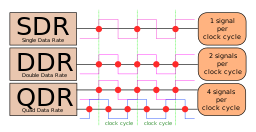This tool converts between Mega Transfers per second and Megahertz and also provides bandwidth in MB/s or GB/s.
Enter
- Type of memory – either DDR SDRAM or SDRAM
- Either the value for MT/s or MHz.
Background
Memory transfer rate determines how quickly data can be accessed and processed by a memory module. This impacts the overall performance of your computer. A higher transfer rate is especially important for tasks that involve large amounts of data, such as gaming, video editing, and running memory-intensive applications.
What is DDR SDRAM?
DDR stands for Double Data Rate. SDRAM stands for Synchronous Dynamic Random-Access Memory.
Compared to single data rate SDRAM, the DDR SDRAM interface transfers at twice the rate by moving data across at both the rising and falling edges of the clock. This is illustrated in the picture below.

MT/s or MHz?
In many situations a memory bank’s speed is specified in MHz. Here is the Corsair product description on Amazon where the speed is specified as 6000 MHz. However on closer examination, the same product is rated at 6000 MT/s on the manufacturer’s page – which is more likely correct.
? MT/s vs MHz – what’s the difference?
How to calculate DDR4 Transfer Rate?
For a module labelled DDR4-3200, the transfer rate is 3200 Mega Transfers per second. Enter this value in the calculator on this page to find the bandwidth or throughput is 25.6 GB/s. The table below shows the range of DDR4 transfer rate values and their corresponding throughput in GB/s.
What is DDR5 Transfer Rate?
DDR5 transfer rates vary between 4000 MT/s to 8000 MT/s. This translates to bandwidth between 32 GB/s to 64 GB/s.
? Try the MT/s to Mb/s calculator (also provides results in Gb/s)
DDR Transfer Rate Table
The table below shows transfer rates for different categories of DDR memory.
| RAM Type | Speed (MT/s) | Bandwidth (GB/s) |
| DDR | 266 | 2.1 |
| 333 | 2.7 | |
| 400 | 3.2 | |
| DDR2 | 533 | 4.3 |
| 667 | 5.3 | |
| 800 | 6.4 | |
| DDR3 | 1066 | 8.5 |
| 1333 | 10.7 | |
| 1600 | 12.8 | |
| 1866 | 14.9 | |
| DDR4 | 2133 | 17.1 |
| 2400 | 19.2 | |
| 2666 | 21.3 | |
| 3200 | 25.6 | |
| DDR5 | 4000 | 32.0 |
| 4400 | 35.2 | |
| 4800 | 38.4 | |
| 5200 | 41.6 | |
| 5600 | 44.8 | |
| 6000 | 48.0 | |
| 6400 | 51.2 | |
| 6800 | 54.4 | |
| 7200 | 57.6 | |
| 7600 | 60.8 | |
| 8000 | 64.0 |
The units for bandwidth are Gigabyte per second. This can be converted to Megabyte per second by multiplying the number by 1000. For instance DDR3 transfer rate of 1866 MT/s has a bandwidth of 14.9 GB/s or 14900 MB/s.
References
[1] Kingston DDR5 Overview
[2] Wikipedia post on DDR SDRAM
Related Calculators and Blog Posts
- Memory Bandwidth
- RAM Latency
- MBps vs Mbps – what’s the difference?
- Mbps to Gbps
- Megabit per second to Megabyte per second
- Megabyte per second to Gigabyte per second
